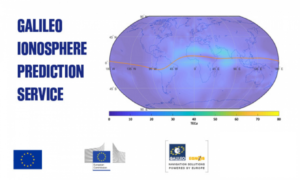Ionospheric effects can be a major source of disruption to GNSS signals, so it is important to be able to predict and compensate for these disturbances. With this in mind, the European Commission-funded Galileo Ionosphere Prediction Service (IPS) monitors ionospheric activity and informs GNSS users in good time of an upcoming event that could disrupt GNSS signals and applications.

The IPS anticipates any degradation of performance, allowing operators to put in place mitigation measures in good time
The IPS monitors and forecasts solar and ionospheric activity and predicts its effect on GNSS signals and on the final performance of user applications. The Service makes it possible to anticipate any degradation of performance, allowing operators to put in place mitigation measures in good time.
The IPS predictions are delivered for ionosphere-related parameters and GNSS performance at both the European and global level. Delivered in three time scales (nowcast, 30 minutes and 24 hours ahead), the alerts are sent to registered users when the IPS predictions exceed thresholds that have been-pre-defined by the user.
Ionosphere Prediction Service – User benefits
The IPS will benefit all users of GNSS signals whose operations can be seriously disrupted by insufficient GNSS performance, in particular the aviation industry, where GNSS performance is important for safety.
In addition, institutional actors interested in operational space weather can reuse the IPS prediction products, compare them with their own predictions, or feed the additional observation and prediction data into their own algorithms to improve the reliability of the forecast. Other users that stand to benefit include electricity and energy grids and professional users such as construction and civil engineering businesses that require stable precise positioning accuracy for their operations.
The prototype has been developed and funded by Horizon 2020, involving a team of engineers and scientists from across Europe, with the support of the Joint Research Centre in Ispra, Italy.
The prototype is now operated by the Joint Research Center, Ispra, where tests and validation campaigns will continue and new products will be developed and added to the product portfolio.
To access the portal, click here.
Ionosphere Prediction Service – Products
The IPS generates more than 160 different products in three areas:
Solar physics
- Automatic detection of solar active regions and evaluation of flare occurrence probability.
- Nowcasting and forecasting of flares and coronal mass ejections (CMEs).
- Measurements of solar energetic particles (SEP) and galactic cosmic rays (GCR).
Ionosphere
- Total electron content (TEC) and scintillation nowcast, short-term and long-term forecast mapping tools on global and/or regional scale.
GNSS performance
- Nowcasting and forecasting of GNSS tracking errors, loss of signal lock and expected levels of positioning errors.
- Detection of travelling ionospheric disturbances (TIDs).
Source: GSA
